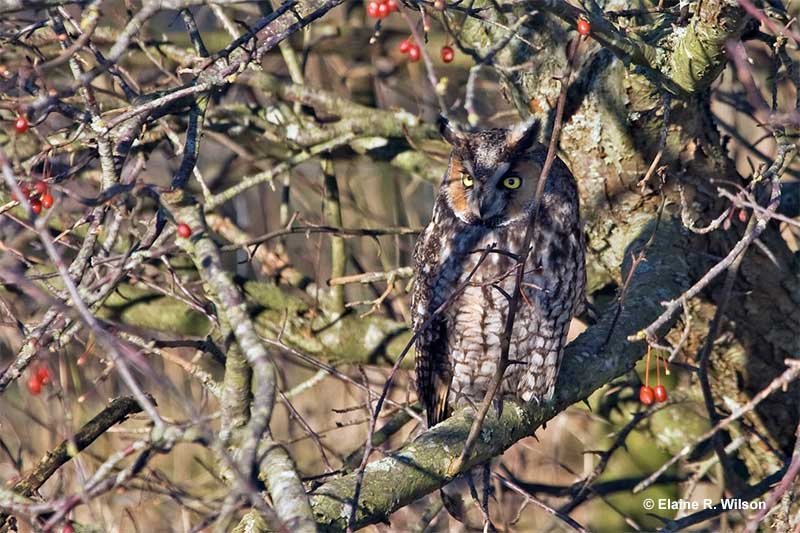
Colorado is one of the most scenic states in the nation. Even better, this beautiful, mountainous state is also one of the best places to see owls!
The owls of Colorado come out at night but a few species are also active in the day.
Do you see owls in Colorado? See this article to learn about and identify the many owls in this beautiful state!
On this page
Owls You Can See in Colorado
According to eBird data and USGS data, twelve owl species are commonly seen in Colorado. Two more rare species are also occasionally seen.
To create a reliable list showing all of the owls in Colorado, we researched eBird data and also organized the birds from most common to least common.
This article also has identification tips and information about owl behavior. We hope it helps!
Great Horned Owl
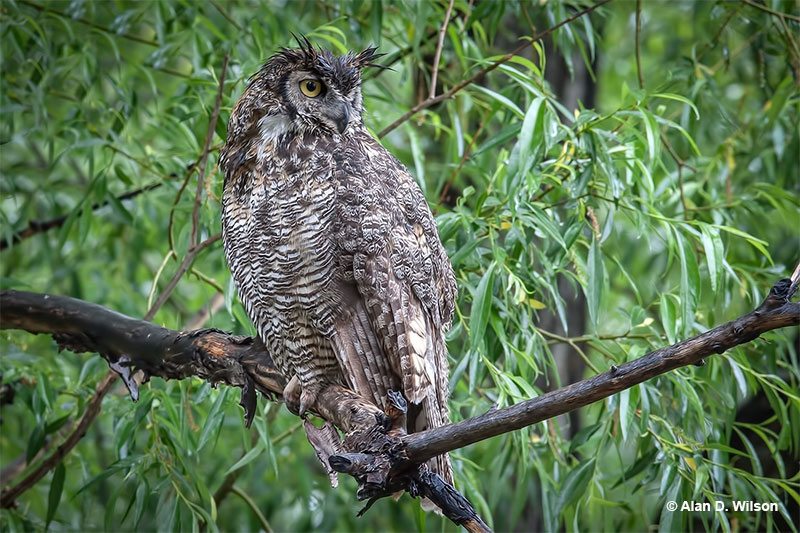
- Range: Permanent resident in much of Alaska, Canada, and the USA.
- Length: 22 inches
- Wingspan: 44 inches
- Call: Makes a low, gruff, “hooo, hoo hoo hoo hoooo”.
The Great Horned Owl is a big, bulky owl with big ear tufts and a black beak. It is mottled gray and brown, has a rufous or gray face, and fine black barring on its underparts. This owl also has a white throat and some dark marks on its breast.
Males and female Great Horned Owls look the same but females are larger. They also have a medium-length tail with dark bands, and long, broad wings.
This nocturnal owl species lives in every possible habitat, including urban areas. They are active from dusk till dawn.
Great Horned Owls have a versatile diet, that includes small mammals (such as mice, rats, and squirrels), larger mammals (rabbits and skunks), smaller birds, including other owls, fish, amphibians, and the list is even longer. These owls eat pretty much everything that isn’t too big to kill.
Key Identifications:
- Big, bulky brown or gray owl with ear tufts and fine barring on its underparts.
- Nests in old stick nests of other large birds, on ledges, and in other situations.
- Watches from a perch or glides over open habitats at night, to catch mammals and some birds on the ground.
The Great Horned Owl lives in every type of habitat in much of North America, including Colorado. It nests in old stick nests of hawks and other birds, or on ledges, and other situations. Great Horned Owls are easily recognized by their big, bulky size, ear tufts, and finely barred underparts.
The talons and grip of this species are so strong, once closed, 28 pounds of pressure are needed to open them!
Burrowing Owl
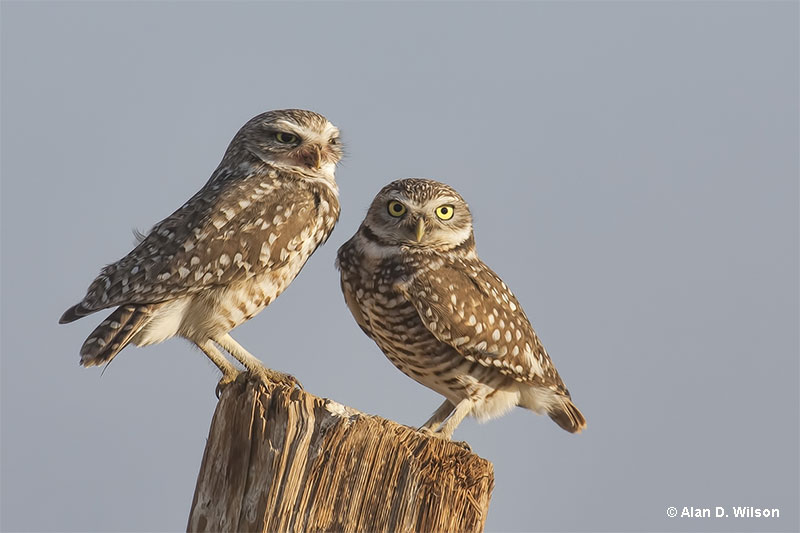
© Alan D. Wilson
- Range: Summer resident in central-southern Canada, the Great Plains, and much of the western USA. Permanent resident in California, Texas, and Florida.
- Length: 9.5 inches
- Wingspan: 21 inches
- Call: Makes a raspy, chattering call, “rap, rip,rip,rip,rip”, and a quail-like, “whup waaah!”.
The Burrowing Owl is a small, long-legged owl with a white throat and white eyebrows. It has a round head, is dark brown with white spots above, and has pale underparts with dark barring.
Males and females look alike, although females are a bit larger. Young birds are uniform dark brown and buff, which blends them to their surroundings.
Adult Burrowing Owls in Florida are more heavily marked below than western birds but juveniles from Florida are paler.
The Burrowing Owl is active day and night in grasslands, deserts, and other open habitats. Burrowing Owls are one of the most common owl species of Colorado.
Key Identifications:
- Small, long-legged owl with a round head, and some brown barring on pale underparts.
- Lives in grasslands and other wide-open habitats.
- Nests in burrows made by prairie dogs and other animals although birds in Florida make their own burrows.
- Catch small animals on the ground at any time of the day or night.
The Burrowing Owl occurs in open habitats in south-central Canada, the western USA, and Florida. It nests in burrows. Burrowing Owls are easily identified by their small size, round head, barred underparts, and terrestrial behavior. Like some other animals that live in burrows, this species is more tolerant of carbon dioxide than other birds.
Eastern Screech-Owl
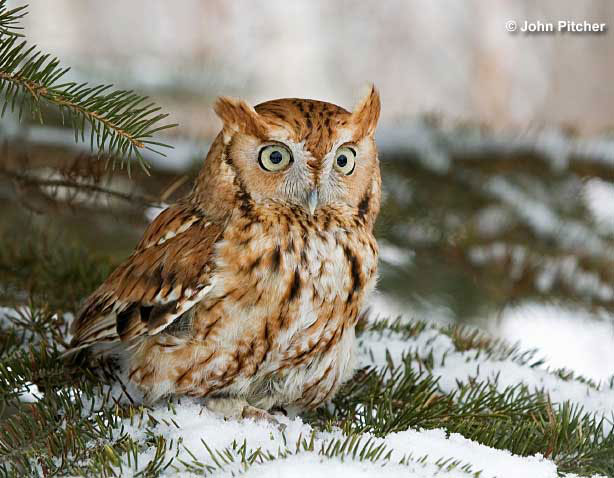
- Range: Permanent resident in parts of southeastern Canada, and in much of the eastern USA.
- Length: 8.5 inches
- Wingspan: 20 inches
- Call: Makes a rather high-pitched, descending whinny call, and a tremulous, vibrating call on the same pitch, “wududududududududududu”.
The Eastern Screech Owl is a small owl with ear tufts. It can be reddish, brown, or mostly gray, has “V”-shaped pale eyebrows, and some black on the edge of its face. It is also mottled above with some white spotting, and has pale underparts with dark barring and streaks.
Males and females look alike but females are a bit larger. This species also has yellow eyes, a pale yellow-gray beak, and some white bands on its broad tail.
Eastern Screech-Owls flap and glide on long, broad wings.
During the day, this owl hides in holes, or in dense vegetation. Eastern Screech Owls are common owls in Colorado.
Key Identifications:
- Small owl with ear tufts and mottled brown or gray plumage that lives east of the Rocky Mountains.
- Lives in a variety of wooded and park-like habitats.
- Nests in tree cavities and nest boxes.
- Swoops down to the ground catch a variety of small animals at night (such as voles, shrews, and different rodents).
The Eastern Screech-Owl lives in wooded and park-like habitats east of the Rocky Mountains in Canada and the USA. Eastern Screech-Owls are identified by their ear tufts, small size, range, and voice. This species is more common than most people realize and often lives in urban situations. Put up a nest box in the backyard and one might move in!
Northern Pygmy-Owl
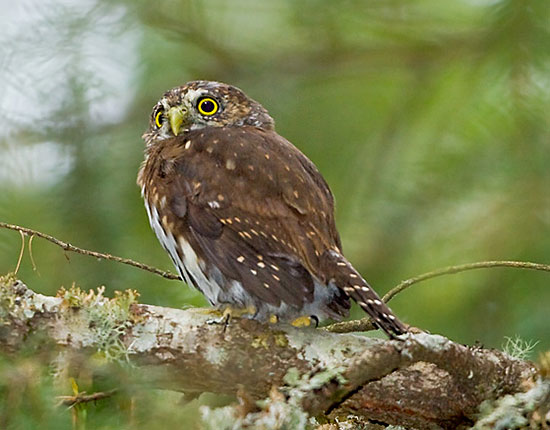
- Range: Permanent resident in the southern half of British Columbia and parts of Alberta, and in mountains and coastal forests of the western USA.
- Length: 6.75 inches
- Wingspan: 12 inches
- Call: Makes a single, well-spaced, whistled “Toot!” call.
The Northern Pygmy Owl is a small, grayish-brown owl with two large black marks on the back of its head. It also has small white spots on its head, breast, and flanks, a longish banded tail, and dark streaking below.
Both sexes of this small owl look the same but females are slightly larger than males.
This uncommon diurnal owl lives in oak and coniferous forest habitats.
Key Identifications:
- Small, dark brown owl with two black marks on the back of its round head, dark brown streaks on pale underparts, and longish dark tail with narrow white bands.
- Lives in forest habitats in western Canada and the western USA south to northern Central America.
- Nests in old woodpecker holes and natural tree cavities. It can also use nest boxes.
- Watches from a perch before flying out to catch small birds during the day.
The Northern Pygmy Owl lives in forest habitats in western Canada and the western USA. Northern Pygmy Owls can be recognized by their small size, round head, and narrow pale bands on a longish, dark tail. Small birds often mob this species and can lead birders to the owl as they try to drive it away from their territories.
Long-eared Owl
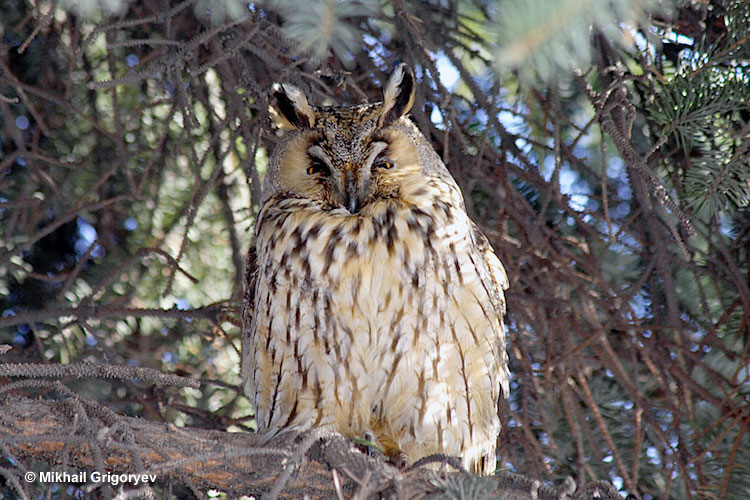
- Range: Migrant in southern Canada, resident and winters in much of the USA. Absent from parts of the Pacific Northwest and southeastern states.
- Length: 15 inches
- Wingspan: 36 inches
- Call: Makes a single, one second long “Hooo!” call at regular intervals.
The Long-eared Owl is a medium-sized, slender owl with long ear tufts. It has an orange face, is mottled gray above, and has dark brown streaks and marks on pale feathers. This owl also has long wings with a rufous patch in its primaries.
Male and female Long-eared Owls look similar but females are larger. This owl species also has yellow eyes, and some pale markings between its eyes and around its dark beak.
Related: How long do owls live?
This nocturnal owl frequents coniferous woodlands near meadows.
Key Identifications:
- Medium-sized, slender owl species with long ear tufts, orange on its face, and long wings with an orange-brown patch near the wingtips.
- Occurs in coniferous and mixed forests near meadows, bogs, and other open areas.
- Nests in old crow, magpie, and hawk nests.
- Glides over open habitats near forest at night to catch small animals on the ground.
The Long-eared Owl occurs in forest with open areas in Canada and much of the lower 48 states. This owl nests in old magpie, crow, and hawk nests. Long-eared Owls can be recognized by their long ear tufts, orange face, slender appearance, and long wings with orange-brown patches near the wingtips. Wintering roosts of Long-eared Owls in Serbia can host thousands of birds!
Western Screech-Owl
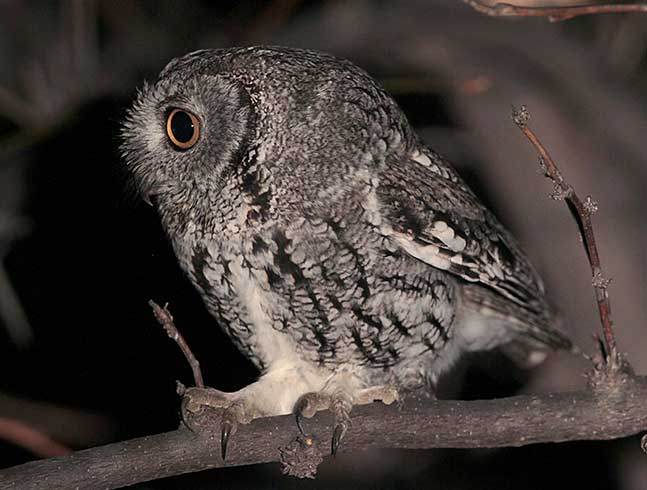
- Range: Permanent resident in British Columbia and the western USA.
- Length: 8.5 inches
- Wingspan: 20 inches
- Call: Has a “bouncing ball” song of short notes, “whup…whup..whu,whu,whu,whu,waa”.
The Western Screech Owl is a small brown or gray owl with ear tufts. It has “V”-shaped pale eyebrows, and some black on the edge of its face. This owl also has mottled upperparts with some white marks, and pale underparts with dark barring and streaks.
Males and females look similar but females are a bit larger. This species also has broad, rounded wings and a broad tail.
This nocturnal owl species lives in a wide variety of woodland and open habitats.
Key Identifications:
- Small, brownish or gray owl with ear tufts, a black border on the edge of its face, some dark streaks and markings on its underparts, and some white marks on its shoulder.
- Lives in many wooded and forest habitats.
- Nests in tree cavities and nest boxes.
- Watches from a perch before flying to catch small animals on the ground and from vegetation at night.
The Western Screech Owl lives in parks and many other woodland habitats in British Columbia, the western USA, including Colorado, and Mexico. It nests in tree cavities, and can be recognized by its small size, ear tufts, fine streaks on its underparts, and calls. This species is nocturnal but often becomes active just before nightfall.
Barn Owl
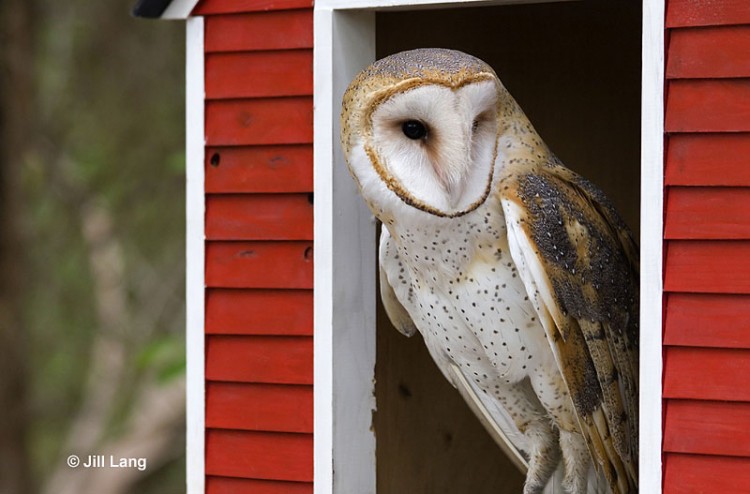
- Range: In Canada, occurs mostly in southwestern British Columbia. In the USA, they live in many areas but are absent from mountains and cold, northern regions. They range north to Washington, Nebraska, Iowa, and New York.
- Length: 16 inches
- Wingspan: 42 inches
- Call: A shrill, loud, hissing “shriiiiii!”
The Barn Owl is a medium to large, pale owl with golden tan and gray upperparts, and white underparts. It has a distinctive, white, heart-shaped face.
Both sexes are alike but females are a bit larger than males and have buff on their chest.
In flight, Barn Owls look like a large, pale, moth-like bird with a big, rounded head.
This owl hunts in grasslands, farms, and other open habitats. In the Americas, Bard Owls are considered to be the American subspecies.
Key Identifications:
- Large pale owl with a heart-shaped face.
- Glides and flutters over fields and other open areas at night.
- Nests in tree cavities, crevices in church steeples and other structures, and next boxes.
- Preys on rats and other small animals.
The Barn Owl lives in many urban and open habitats in regions with mild or no winters. It nests in church steeples, barns, tree cavities, and other similar situations. They are common owls in Colorado. This species is easily recognized by its white, heart-shaped face, and unstreaked, pale plumage. Barn Owls have incredible hearing that helps them catch prey in total darkness.
Northern Saw-whet Owl
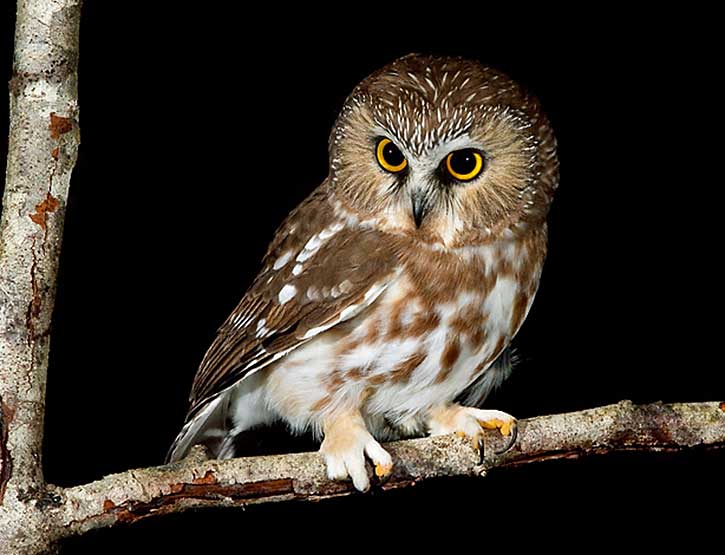
- Range: Lives in coniferous and mixed hardwood forests of Alaska, a large area of Canada, and parts of the northern and western USA.
- Length: 8 inches
- Wingspan: 17 inches
- Call: Makes a repeated tooting whistle call, over and over, “tu, tu, tu, tu, tu, tu, tu, tu, tu”.
The Northern Saw-whet Owl is a small, dark brown owl with a round head and brown streaks on white underparts. It also has some pale streaks on its head, a brown and white face, and some white spotting on its back.
Both sexes look the same but females are a bit larger. This species also has yellow eyes, a dark beak, longish, rounded wings, and a short, broad tail.
Interestingly, Northern Saw-whet Owls are not too monogamous, males mate with different females.
This nocturnal owl lives in forested habitats.
Key Identifications:
- Small, dark brown owl with a round head, broad white eyebrows, and thick dark streaks on pale underparts.
- Occurs in dense coniferous and mixed forest.
- Nests in old woodpecker holes and can use nest boxes.
- Swoops down to catch insects and small animals at night.
The Northern Saw-whet Owl breeds in coniferous and mixed forest in Canada and the northern and western USA, including Colorado. It nests in old woodpecker holes and is identified by its small size, round head, thick white eyebrows, and thick streaks on pale underparts. They are threatened by habitat loss, whit their numbers declining.
The name of this owl refers to the similarity of its call to the sound made by sharpening an antique old saw blade.
Boreal Owl
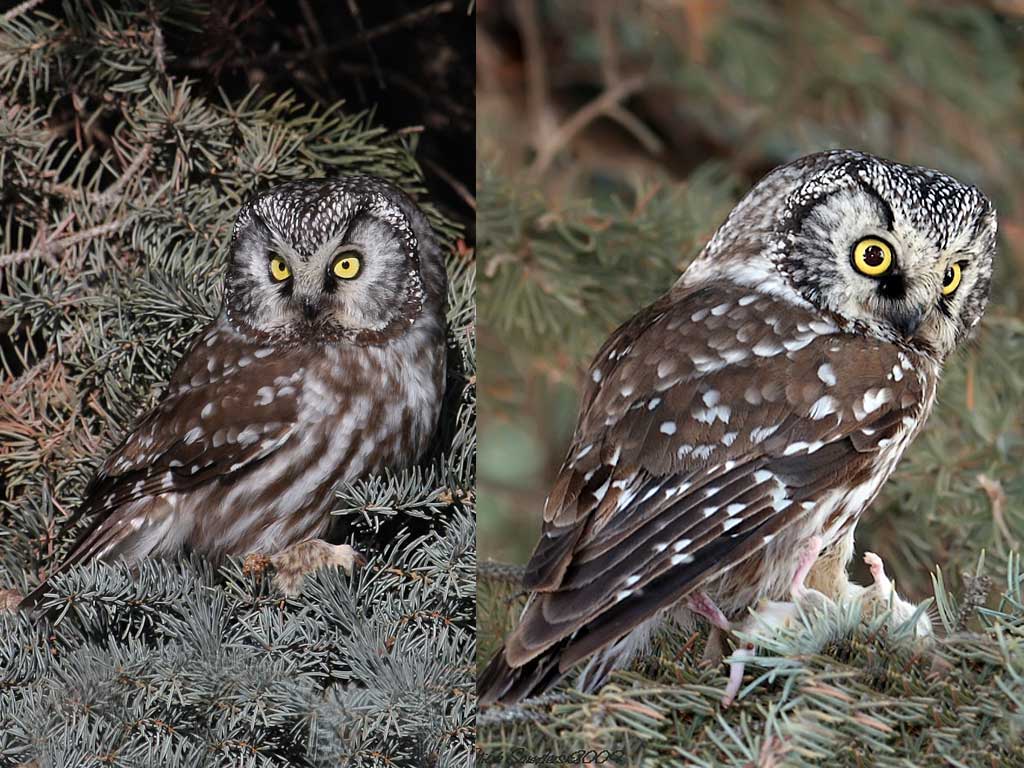
Boreal Owl
- Range: A permanent resident in a large part of Canada, Alaska, and parts of the Cascades and Rocky Mountains. Some migrate to southern Canada and the northern USA. Common in Colorado.
- Length: 10 inches
- Wingspan: 21 inches
- Call: Makes a slightly rising, rapid serious of twelve brief hoot notes, “too, too, too, too, tu, tu, tu, tu, tu, tu, tu, tu”.
The Boreal Owl is a small owl species with a round or square-shaped head, and white face with a broken black border. It is dark brown with white spotting and has a black and white head.
Males and females look alike although females are larger. This species also has yellow eyes, and a pale beak. Juvenile birds are mostly dark brown.
Boreal Owls have a few pale narrow bands on a broad tail, and glide on long, broad wings.
Key Identifications:
- Small, dark brown and white owl with white spotting and a squared, black and white head.
- Lives in boreal and montane forest, some also winter at lower elevations and just south of its breeding range.
- Nests in old woodpecker holes and nest boxes.
- Watches from a perch before swooping down onto small animals at night.
The Boreal Owl mostly occurs in cold, boreal and montane forest. It nests in old woodpecker holes and nest boxes. Boreal Owls are identified by their small size, black and white squared head, and pale spots on their dark brown upperparts. Female Boreal Owls can be twice as heavy as their male counterparts.
Flammulated Owl
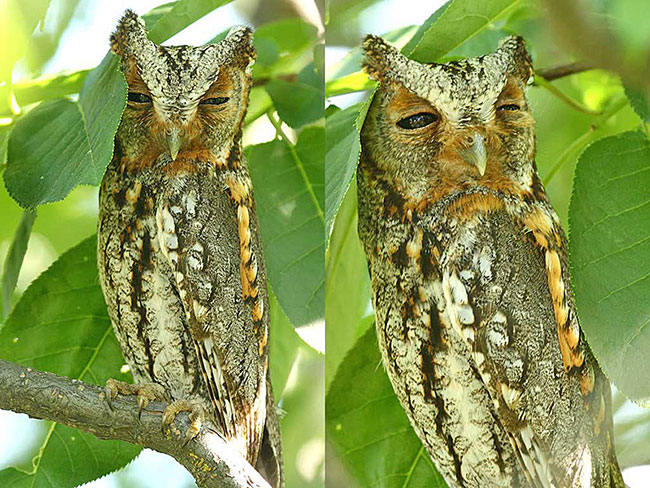
- Range: Summer resident in a small area of southern British Columbia, and in mountains in the western USA.
- Length: 6.75 inches
- Wingspan: 16 inches
- Call: Makes one, low-pitched “woot” call at regular, well-spaced intervals.
The Flammulated Owl is a small, thrush-sized owl with short ear tufts and dark eyes. It is mottled gray and reddish brown with pale eyebrows and some white spotting. This owl also has thick black streaks on mottled gray and white underparts.
Males and females look the same although females are a bit bigger. This species also has long wings and a short, broad tail.
Key Identifications:
- Small, mottled gray and reddish-brown owl with ear tufts and dark eyes.
- Breeds and winters in montane forest habitats.
- Nests in old woodpecker holes.
- Picks moths and other insects from foliage in flight, at night.
The Flammulated Owl breeds in Aspen, Ponderosa Pine, and other montane forest habitats in southern British Columbia, the western USA, including Colorado, and Mexico. It migrates to montane habitats in Mexico and Central America for the winter.
This owl nests in old woodpecker holes and is recognized by its small size, ear tufts, reddish-brown highlights, and dark eyes. The calls of this species are surprisingly low-pitched but, sounding like a larger owl could help scare off potential predators.
Short-eared Owl
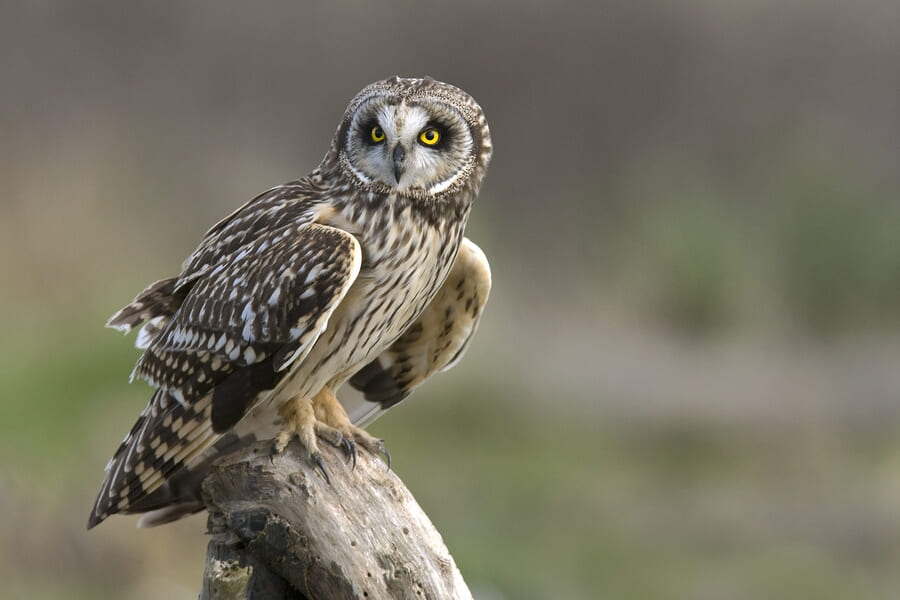
- Range: Summer resident in Alaska, Canada, and the western and central USA. Northern birds migrate to the USA, south to California and Texas.
- Length: 15 inches
- Wingspan: 38 inches
- Call: Makes a hoarse, raspy, cat-like call, “rehw”.
The Short-eared Owl is a medium-sized, pale brown owl with dark eye patches on a pale face. They have a dark breast and streaks on pale underparts. This species has long wings with buff wing patches.
Both sexes look similar but females are a bit larger and usually darker and buffier.
This owl is active day and night in open fields.
Key Identifications:
- Medium-sized pale brown and buffy owl with very short ear tufts.
- Dark eye patches on a pale face and long wings with buff patches near the wingtips.
- Nests on the ground in dense vegetation.
- Glides over open fields to catch small animals on the ground.
The Short-eared Owl lives in open habitats in Alaska, Canada, and much of the USA. Short-eared Owls can be spotted in Colorado. It nests on the ground in dense vegetation. This species is identified by its dark eye patches on a pale face, and long wings with buff patches near the wingtips. On account of their long migrations, Short-eared Owl have become established on Hawaii, and the Galapagos Islands.
Snowy Owl
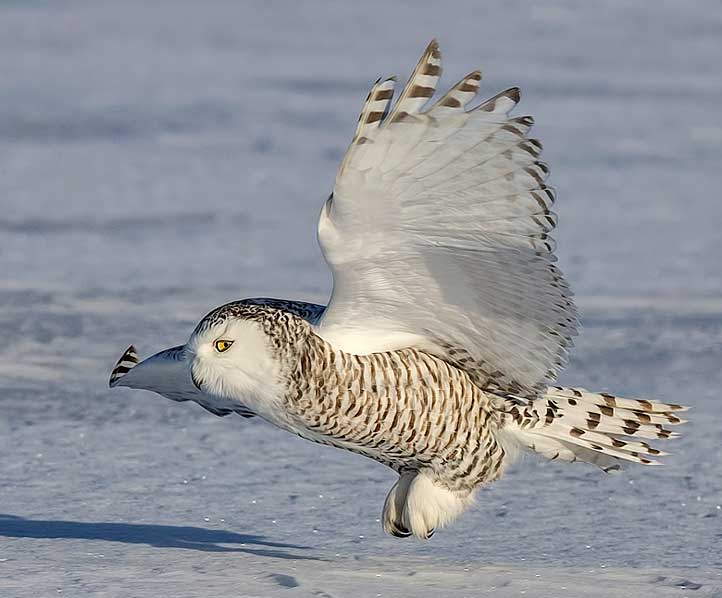
- Range: Summer resident in northern Alaska and northern Canada. It winters in Canada and the northern USA.
- Length: 23 inches
- Wingspan: 52 inches
- Call: Usually quiet but occasionally makes a low, gruff call, “whew…whuh”.
The Snowy Owl is a big, owl with white plumage and a round head and yellow eyes. Some males are mostly white but most have some small dark marks. Females and young birds have white faces and varying degrees of black barring.
Females are a bit larger than males and have more black markings than males. Snowy Owls also have long, broad wings and a broad tail.
This owl species is active during the day and lives in wide-open habitats.
Key Identifications:
- Big white owl with a round head, and varying degrees of black or dark gray barring and spots.
- Lives in tundra and winters in wide open habitats.
- Nests on the ground, on elevated spots in Arctic tundra.
- Watches from a perch and glides low to catch small animals on the ground.
The Snowy Owl lives in Arctic habitats but also winters in open areas in Alaska, Canada, and the northern USA. It nests on elevated spots on the ground in the Arctic tundra. This species is unmistakable; it is the only big, mostly white owl. The wide open terrain at airports are ideal for this species and are some of the best spots to see a Snowy Owl.
Rare Owls in Colorado
Barred Owl
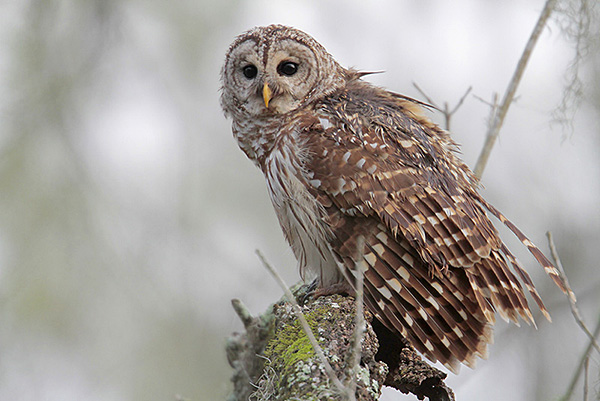
Photograph © Greg Lavaty.
- Range: A permanent resident in most forested areas in Canada, parts of some Pacific Northwestern states, and most of the eastern USA.
- Length: 21 inches
- Wingspan: 42 inches
- Call: Makes loud hooting and caterwalling sounds, “Who cooks for you?! Who cooks for youaaaal!”
The Barred Owl is a medium to large owl with a round head and a narrow black border on its pale gray face. It has dark brown upperparts with white markings, and dark brown streaks on its belly.
This species also has a yellowish beak and dark eyes. Both sexes look the same except that females are a bit larger than males.
The Barred Owl flaps and glides on big, broad wings. It also has a medium-length, broad tail with a few dark brown bands.
Key Identifications:
- Big owl with a round head that has white marks on dark brown upperparts, and dark brown streaks on pale underparts.
- Perches and swoops through wooded areas at night but can also be active in the day.
- Nests in tree cavities and in abandoned nests of crows and hawks.
- Catches a wide variety of small animals.
The Barred Owl lives in deciduous and coniferous forest and woodlands. It nests in the abandoned nests of raptors and crows, and in tree cavities. Barred Owls are recognized by their round head and dark streaks on pale underparts. Male and female Barred Owls make bizarre, loud laughing sounds when they call together.
Spotted Owl
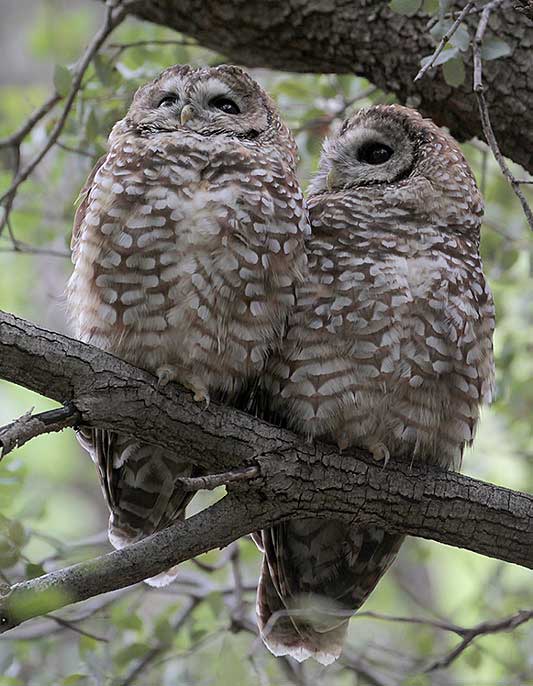
Photograph © Greg Lavaty
- Range: A permanent resident in the Pacific Northwest, the Sierra Nevada, and mountains in the southwestern USA.
- Length: 17.5 inches
- Wingspan: 40 inches
- Call: Makes abrupt, bark-like hoots, “whoot….oot oot..hoo…whew”.
The Spotted Owl is a medium-sized owl with a round head, dark eyes, and a narrow black border on its pale brown face. It also has dark brown upperparts with pale markings, and dark brown and white spotting on its underparts.
Males and females look the same but females are a bit larger. This species also has broad wings and dark bands on its broad tail.
This uncommon, nocturnal owl lives in mature coniferous and oak forests.
Key Identifications:
- Medium-sized, dark brown owl with white spotting on its back and flanks, and a round head.
- Lives in mature forest and woodlands.
- Nests in old raptor nests, in tree cavities, and on top of broken off trees.
- Watches from a perch before flying down to catch small animals on the ground, at night.
The Spotted Owl is a rare resident of mature forest, mostly in parts of the western and southwestern USA, even in Colorado, and Mexico. It nests in old raptor nests, tree cavities, and broken off tree tops. Spotted Owls are identified by their round heads and white spotting on their brown flanks and back. In most parts of its range, this species requires old forest with healthy populations of its main prey; the Northern Flying Squirrel.
Owls in Colorado – Frequently Asked Questions
Are owls common in Colorado?
Owls are common in Colorado. Several species are common, including the Great Horned Owl, Burrowing Owl, and the Eastern Screech-Owl
What is the largest owl in Colorado?
The largest owl in Colorado is the Great Horned Owl. This big owl is 22 inches long and weighs 3.1 pounds.
Are owls rare in Colorado?
No, owls are not rare in Colorado. At least 12 species are regularly seen.
Are Great Horned Owls native to Colorado?
Yes, Great Horned Owls are native to Colorado and one of the most common owl species in the state.
See more: Hawks in Colorado | Ducks in Colorado

